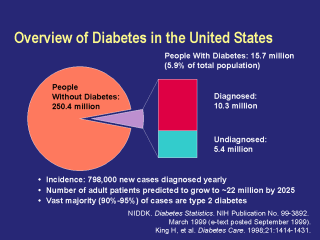| front |1 |2 |3 |4 |5 |6 |7 |8 |9 |10 |11 |12 |13 |14 |15 |16 |17 |18 |19 |20 |21 |22 |23 |24 |25 |26 |27 |28 |29 |30 |31 |32 |33 |34 |35 |36 |review |
 |
Diabetes mellitus, which is characterized by
high concentrations of blood glucose resulting from defects in insulin
secretion and/or insulin action, is one of the most common chronic illnesses
in the United States. This disease affects 15.7 million people, or 5.9% of
the population. Of these, it is estimated that one out of every three has
not been medically diagnosed. Nearly 800,000 individuals are diagnosed each year with diabetes. By the year 2025, it is estimated that nearly 22 million adults in the United States will have diabetes. Similarly, the number of patients with diabetes worldwide is predicted to increase substantially over this period. The most common form—type 2 diabetes—accounts for 90% to 95% of all diagnosed cases, whereas type 1 diabetes accounts for 5% to 10% of all diagnosed cases. Other forms of diabetes may result from specific genetic syndromes, surgery, drugs, malnutrition, infections, or other illnesses; these account for 1% to 2% of all diagnosed cases. Finally, gestational diabetes occurs in 2% to 5% of all pregnancies but resolves once the pregnancy is completed. In some studies, in nearly 40% of women who had gestational diabetes, diabetes later developed. NIDDK. Diabetes Statistics. NIH Publication No. 99-3892. March 1999 (e-text posted September 1999). Available at: http://www.niddk.nih.gov/health/diabetes/pubs/dmstats/dmstats.htm
Accessed July 19, 2000. |